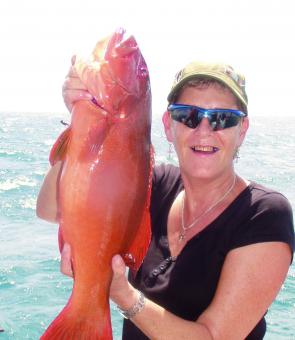The offshore fishing has certainly improved recently but it has not all been plain sailing. Meanwhile the inshore fishery has become somewhat challenging to produce rewards despite putting in the effort.
As expected for this time of year fishing the reef has been the most productive. But there are still days when the pickings are slim, which is when it’s helpful to look back at productive fishing patterns from previous months. While there aren’t really any guarantees in fishing, by recording catches and reports from charters and other anglers over the past two months there are a couple of standout periods when certain fish are biting well.
Days leading into the full moon have been patchy, but a few days after the full moon, the coral trout have really come on the chew. They seem to mainly bite in 15-25m of water around bommies holding bait.
A pattern for trout feeding has also emerged in the last two months. The trout have been going into overdrive for three or four days when the tides lose their sting, heading into the slackest tides of the month. Other than this the trout have fed spasmodically coming in with sweetlip, baldy bream and stripeys. When the trout are aggressive, less by-catch seems to come overboard.
Red emperor and nannygai in deeper water have fired up on the turn of the slack tides moving into the new and full moon phases. Reports indicate this has been the case for the past couple of months. Other targets at this time of the tide include spangled emperor, brassy trevally and Spanish mackerel. Some days have been more explosive than others with the best results occurring on the outgoing tide. If the weather permits, night sessions on the reds have been twice as good than in the day.
Bread and butter species such as grunter, bream, whiting and flathead, have been the main focus inshore. The barra have shut down for winter, the jacks are getting smaller and the fingermark are patchy, so July is a good month to hone your fishing skills on the bread and butter species.
There have been some monster dusky flathead caught at river mouths using small lures or soft plastics bumped across the sand floor bed. These monsters have been captured on picture postcard days leading into the new and full moons on an incoming tide and on the first of the outgoing tide.
Trevally and queenfish dominate proceedings inside the river mouths via channels using live baits drifted in the current on the incoming tide. Monster queenfish to 1m+ have featured at the Daintree River and at the mouth of Mowbray River. Once again nice clam days with clean water seem to be the key.
On the edges of the channels there have been some nice permit and golden trevally taken on fresh peeled prawns or pumped yabbies on incoming tides. There has also been the occasional tussle with big shovelnose rays when concentrating on these edges and across the sand bars. Try using 4-6kg line on these species for some adrenaline pumping action. Permit and golden trevally have also bobbed up along our beaches at times when targeting whiting.
The deeper holes upstream have been producing tarpon on soft plastics flies at high tide. The usual suspects such as bream and grunter have also been biting all day on peeled prawns, as well as squid inside the local harbour around pylons and rock walls. These species will keep the kids entertained for hours.
In other news there have been solid catches of mud crabs in our local systems over the past month or two. But I expect the bucks will now concentrate themselves towards the coastal mangroves waiting for Jennies to return from breeding at sea. This possibility of a few good crabs has turned many average days on the water into winners in the last few months.
Reads: 1847
Coral trout have consistently fished well over the last few months few days after the full moon.




